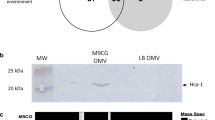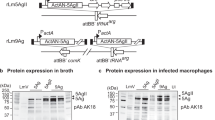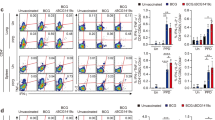Abstract
With the advent of HIV and the widespread emergence of drug-resistant strains of Mycobacterium tuberculosis, newer control strategies in the form of a better vaccine could decrease the global incidence of tuberculosis. A desirable trait in an effective live attenuated vaccine strain is an ability to persist within the host in a limited fashion in order to produce important protective antigens in vivo1,2. Attenuated M. tuberculosis vaccine candidates have been constructed by deleting genes required for growth in mice3,4,5. These candidate vaccines did not elicit adequate protective immunity in animal models, due to their inability to persist sufficiently long within the host tissues. Here we report that an auxotrophic mutant of M. tuberculosis defective in the de novo biosynthesis of pantothenic acid (vitamin B5) is highly attenuated in immunocompromised SCID mice and in immunocompetent BALB/c mice. SCID mice infected with the pantothenate auxotroph survived significantly longer (250 days) than mice infected with either bacille Calmette-Guerin (BCG) vaccine or virulent M. tuberculosis (77 and 35 days, respectively). Subcutaneous immunization with this auxotroph conferred protection in C57BL/6J mice against an aerosol challenge with virulent M. tuberculosis, which was comparable with that afforded by BCG vaccination. Our findings highlight the importance of de novo pantothenate biosynthesis in limiting the intracellular survival and pathogenesis of M. tuberculosis without reducing its immunogenicity in vaccinated mice.
This is a preview of subscription content, access via your institution
Access options
Subscribe to this journal
Receive 12 print issues and online access
$209.00 per year
only $17.42 per issue
Buy this article
- Purchase on Springer Link
- Instant access to full article PDF
Prices may be subject to local taxes which are calculated during checkout



Similar content being viewed by others
Change history
23 September 2002
This was incorrect in AOP version but corrected in print. Transposed panels b and care now corrected in this updated figure.
References
Kanai, K. & Yanagisawa, K. Studies on the reinfection in experimental tuberculosis of guinea pigs. Jpn. J. Med. Sci. Biol. 8, 115–127 (1955).
McKenney, D. et al. Broadly protective vaccine for Staphylococcus aureus based on an in vivo-expressed antigen. Science 284, 1523–1527 (1999).
Jackson, M. et al. Persistence and protective efficacy of a Mycobacterium tuberculosis auxotroph vaccine. Infect. Immun. 67, 2867–2873 (1999).
Hondalus, M.K. et al. Attenuation of and protection induced by a leucine auxotroph of Mycobacterium tuberculosis. Infect. Immun. 68, 2888–98 (2000).
Smith, D.A., Parish, T., Stoker, N.G. & Bancroft, G.J. Characterization of auxotrophic mutants of Mycobacterium tuberculosis and their potential as vaccine candidates. Infect. Immun. 69, 1142–1150 (2001).
Cox, J.S., Chen, B., McNeil, M. & Jacobs, W.R., Jr. Complex lipid determines tissue-specific replication of Mycobacterium tuberculosis in mice. Nature 402, 79–83 (1999).
Camacho, L.R., Ensergueix, D., Perez, E., Gicquel, B. & Guilhot, C. Identification of a virulence gene cluster of Mycobacterium tuberculosis by signature-tagged transposon mutagenesis. Mol. Microbiol. 34, 257–267 (1999).
Glickman, M.S., Cox, J.S. & Jacobs, W.R., Jr. A novel mycolic acid cyclopropane synthetase is required for cording, persistence, and virulence of Mycobacterium tuberculosis. Mol. Cell. 5, 717–727 (2000).
De Voss, J.J. et al. The salicylate-derived mycobactin siderophores of Mycobacterium tuberculosis are essential for growth in macrophages. Proc. Natl. Acad. Sci. USA 97, 1252–1257 (2000).
Manca, C. et al. Virulence of a Mycobacterium tuberculosis clinical isolate in mice is determined by failure to induce Th1 type immunity and is associated with induction of IFN-α/β. Proc. Natl. Acad. Sci. USA 98, 5752–5757 (2001).
McKinney, J.D. et al. Persistence of Mycobacterium tuberculosis in macrophages and mice requires the glyoxylate shunt enzyme isocitrate lyase. Nature 406, 735–738 (2000).
Jackowski, S. Escherichia coli and Salmonella typhimurium: Cellular and Mol. Biol. 687–694 (American Society for Microbiology, Washington, D.C., 1996).
Steyn, A.J. et al. Mycobacterium tuberculosis WhiB3 interacts with RpoV to affect host survival but is dispensable for in vivo growth. Proc. Natl. Acad. Sci. USA 99, 3147–3152 (2002).
Kaushal, D. et al. Reduced immunopathology and mortality despite tissue persistence in a Mycobacterium tuberculosis mutant lacking alternative sigma factor, SigH. Proc. Natl. Acad. Sci. USA 99, 8330–8335 (2002).
Weber, I., Fritz, C., Ruttkowski, S., Kreft, A. & Bange, F.C. Anaerobic nitrate reductase (narGHJI) activity of Mycobacterium bovis BCG in vitro and its contribution to virulence in immunodeficient mice. Mol. Microbiol. 35, 1017–1025 (2000).
Saliba, K.J. & Kirk, K. H+-coupled pantothenate transport in the intracellular malaria parasite. J. Biol. Chem. 276, 18115–18121 (2001).
Jackowski, S. & Alix, J.H. Cloning, sequence, and expression of the pantothenate permease (panF) gene of Escherichia coli. J. Bacteriol. 172, 3842–3848 (1990).
Slyshenkov, V.S., Moiseenok, A.G. & Wojtczak, L. Noxious effects of oxygen reactive species on energy-coupling processes in Ehrlich ascites tumor mitochondria and the protection by pantothenic acid. Free Radic. Biol. Med. 20, 793–800 (1996).
Afshar, K., Gonczy, P., DiNardo, S. & Wasserman, S.A. fumble encodes a pantothenate kinase homolog required for proper mitosis and meiosis in Drosophila melanogaster. Genetics 157, 1267–1276 (2001).
Collins, F.M. et al. Protection to mice afforded by BCG vaccines against an aerogenic challenge by three mycobacteria of decreasing virulence. Tubercle 66, 267–276 (1985).
Behr, M.A. et al. Comparative genomics of BCG vaccines by whole-genome DNA microarray. Science 284, 1520–153 (1999).
Bardarov, S. & Jacobs, W.R.J. One step allelic exchange in mycobacteria using in vitro generated conditional transducing phages. Vol. 6 034 (USA, 1999).
Raman, S. et al. The alternative sigma factor SigH regulates major components of oxidative and heat stress responses in Mycobacterium tuberculosis. J. Bacteriol. 183, 6119–6125 (2001).
Acknowledgements
We thank J. Chan, S. Bardarov for helpful comments and J. Kriakov for providing the phage phAE159. Correspondence and requests for materials should be addressed to W.R.J.
Author information
Authors and Affiliations
Corresponding author
Ethics declarations
Competing interests
The authors declare no competing financial interests.
Rights and permissions
About this article
Cite this article
Sambandamurthy, V., Wang, X., Chen, B. et al. A pantothenate auxotroph of Mycobacterium tuberculosis is highly attenuated and protects mice against tuberculosis. Nat Med 8, 1171–1174 (2002). https://doi.org/10.1038/nm765
Received:
Accepted:
Published:
Issue Date:
DOI: https://doi.org/10.1038/nm765
This article is cited by
-
The pathogenic mechanism of Mycobacterium tuberculosis: implication for new drug development
Molecular Biomedicine (2022)
-
Pantothenate biosynthesis is critical for chronic infection by the neurotropic parasite Toxoplasma gondii
Nature Communications (2022)
-
Mutations Associated with Pyrazinamide Resistance in Mycobacterium tuberculosis: A Review and Update
Current Microbiology (2022)
-
An amiloride derivative is active against the F1Fo-ATP synthase and cytochrome bd oxidase of Mycobacterium tuberculosis
Communications Biology (2022)
-
The molecular basis of pyrazinamide activity on Mycobacterium tuberculosis PanD
Nature Communications (2020)



